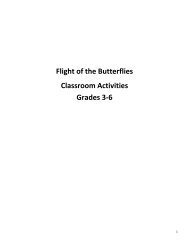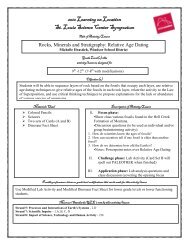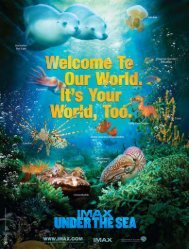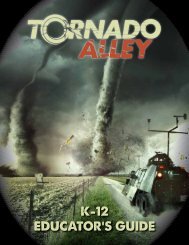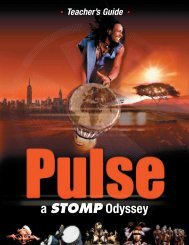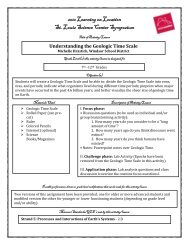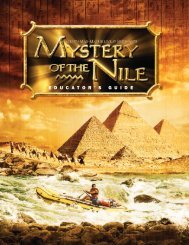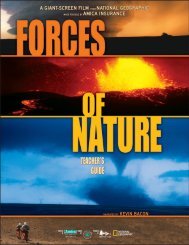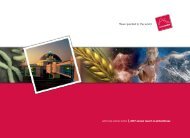Create successful ePaper yourself
Turn your PDF publications into a flip-book with our unique Google optimized e-Paper software.
Educator’s Resource Guide<br />
GRADES 6<strong>–</strong>8<br />
Dear Teachers: Welcome to dynamic science<br />
activities inspired by the IMAX film Under the Sea.<br />
These materials, created by Scholastic Inc., IMAX Corporation,<br />
and Warner Bros. Pictures, can build student skills through<br />
engaging critical-thinking activities and hands-on<br />
experiments. You can also further students’ learning<br />
experience with a film field trip (see below), allowing students<br />
to experience face-to-face encounters with some of the<br />
underwater world’s most mysterious and unusual creatures.<br />
We hope you enjoy Under the Sea!<br />
Worksheet Guide: For additional educational worksheets, visit WWW.IMAX.COM/UNDERTHESEA.<br />
Worksheet 1:<br />
Coral Crisis<br />
Summary: Students will<br />
hone graph-reading skills<br />
as they learn how many of<br />
the world’s coral reefs are<br />
at risk.<br />
Skills/Curriculum:<br />
• Graph-reading skills<br />
• Critical thinking<br />
• Coral reefs<br />
• Pollution<br />
Worksheet 2:<br />
Creatures of the Deep<br />
Summary: Students will<br />
learn the characteristics of<br />
the group of invertebrates<br />
called cephalopods.<br />
Worksheet 3:<br />
Oceans<br />
Summary: Students will<br />
learn how carbon dioxide<br />
affects the oceans and<br />
calculate how daily activities<br />
release carbon dioxide.<br />
Skills/Curriculum:<br />
• Math skills<br />
• Fossil fuels<br />
• Carbon dioxide<br />
• Acids<br />
• Coral reefs<br />
NSES Standards:<br />
• Properties and changes<br />
of properties in matter<br />
• Understanding about<br />
science and technology<br />
Worksheet 4:<br />
Hot Spot<br />
Worksheet 5:<br />
Food Web<br />
Summary: Students will<br />
learn about the coral reef<br />
ecosystem. They will create a<br />
food web for organisms in the<br />
ecosystem.<br />
Skills/Curriculum:<br />
• Diagram-reading skills<br />
• Ecosystems<br />
• Food webs<br />
Summary: Students will<br />
learn about the Coral<br />
Triangle—the region of<br />
the world with the highest<br />
diversity of coral.<br />
Skills/Curriculum:<br />
• Reading comprehension<br />
• Invertebrates<br />
• Cephalopods<br />
Skills/Curriculum:<br />
• Map-reading skills<br />
• Geography<br />
• Ecosystems<br />
• Biodiversity<br />
• Coral reefs<br />
NSES Standards:<br />
• Populations, resources,<br />
and environments<br />
• Science and technology<br />
in society<br />
NSES Standards:<br />
• Diversity and adaptations<br />
of organisms<br />
• Form and function<br />
NSES Standards:<br />
• Populations and ecosystems<br />
• Structure of the earth<br />
system<br />
NSES Standards:<br />
• Structure and function in<br />
living systems<br />
• Regulation and behavior<br />
Lesson Ideas: Start a<br />
discussion about humancaused<br />
pollution. Ask<br />
students how pollution<br />
created on land can affect<br />
organisms that live in the<br />
ocean.<br />
Lesson Ideas: Extend<br />
the lesson by having<br />
students research the most<br />
mysterious cephalopod: the<br />
giant squid. Find out why<br />
this creature is so hard for<br />
scientists to study.<br />
Lesson Ideas: Extend<br />
the lesson by having<br />
students calculate their<br />
total “carbon footprint” at<br />
www.zerofootprintkids.<br />
com. Have them track<br />
their footprint over time.<br />
Lesson Ideas: Start a class<br />
discussion about biodiversity<br />
by having students compare<br />
the life seen around their<br />
school with that found in a<br />
rain forest. Why might it be<br />
important to protect areas<br />
with a lot of diversity of life?<br />
Lesson Ideas: Start a<br />
discussion about the<br />
interdependence of animals by<br />
thinking about the organisms<br />
they need in order to survive.<br />
For instance, they need plants<br />
and animals for food. They need<br />
trees to build homes.<br />
WORKSHEET ANSWERS: Worksheet 1: 1. 58%; 2. 42%; 3. Southeast Asia; 4. 25,000 square kilometers; 5. Yes, the Coral Triangle is in an area that is at high risk; 6. It should be protected because<br />
it has a high diversity of organisms and reefs in that area are at high risk. Worksheet 2: 1. They are carnivores, invertebrates, live in the ocean, and have arms called tentacles; 2. It has an outer<br />
shell; 3. The octopus has the largest brain relative to body size of all invertebrates; 4. By having them navigate mazes, complete memory tasks; 5. No one had ever seen a live giant squid until<br />
recently. Worksheet 3: “Transportation” ways to reduce: Ride your bike or walk instead of getting a ride in a car. Drive smaller cars. “Electricity” ways to reduce: Turn off lights when you leave a<br />
room. Watch less television. Turn off computers when not using them. Worksheet 4: 1. Southern; 2. Australia; 3. It causes water to warm and causes the water to become acidic; 4. Fish and sea<br />
turtles would die off; 5. Local people need the coral reefs for food and jobs. Worksheet 5: If plankton disappeared the whole food web could disappear.<br />
BOOK AN IMAX ®<br />
FIELD TRIP<br />
Engage your students with an unforgettable learning experience.<br />
IMAX ® is a registered trademark of IMAX Corporation.<br />
© 2008 Warner Bros. Ent. All Rights Reserved.<br />
Each of the activities inside provides eye-opening extensions connected<br />
to viewing Under the Sea. IMAX films are ideal teaching tools that:<br />
• Present new knowledge in a powerful, popular medium<br />
• Inspire thoughtful and lively classroom discussion<br />
• Motivate students for extended learning<br />
Field trips are economical and easily arranged. To book a field trip,<br />
contact your local IMAX theatre today! For locations near you,<br />
visit www.IMAX.com.
Worksheet #1<br />
Name:<br />
CORAL Crisis<br />
Grade:<br />
More than 1 million plants and animals live in the world’s coral<br />
reefs. Coral reefs protect coastlines from storm damage, and<br />
organisms that live in them have been used to develop drugs to treat diseases.<br />
Many of the world’s coral reefs are at risk. The threats include destructive fishing practices and pollution.<br />
Global warming is also threatening reefs. Scientists have found that warming ocean waters are killing off<br />
many coral plants. Use the graphs to answer questions about the threats to coral reefs.<br />
PERCENTAGE OF THE WORLD’S REEFS<br />
THAT ARE AT RISK OF DISAPPEARING<br />
TOTAL AREA OF CORAL REEFS THAT ARE AT<br />
MEDIUM TO HIGH RISK OF DISAPPEARING<br />
High<br />
27%<br />
Low<br />
42%<br />
Area (square km)<br />
Photo copyright © 2008 Warner Bros. Entertainment Inc. Photo: Richard Herrmann, Location: “J” Bay, Normandy Island, Milne Bay.<br />
© 2008 Warner Bros. Ent. All Rights Reserved.<br />
Medium<br />
31%<br />
1. According to the pie chart, what percentage of<br />
the world’s reefs are at high or medium risk<br />
of disappearing?<br />
2. There are approximately 255,000 square<br />
kilometers of coral reefs in the world. Look at the<br />
pie chart. Roughly what area of coral reef is at low<br />
risk?<br />
3. In which region of the world is the largest area of<br />
coral reef at risk?<br />
BONUS<br />
ACTIVITY<br />
Under the Sea<br />
Under the Sea highlights some of the threats<br />
facing the coral reefs in the Indian and Pacific<br />
Oceans. Write a paragraph describing some<br />
of these threats and the damage they inflict<br />
on coral reefs.<br />
Coral plants in the waters off Papua<br />
New Guinea provide an important<br />
habitat for fish and other organisms.<br />
Region<br />
4. Approximately what area of coral reef in the<br />
Caribbean and the Indian Ocean is at risk?<br />
5. The Coral Triangle in Southeast Asia holds the<br />
greatest diversity of coral in the world. Based on<br />
the bar graph, are the reefs in the Coral Triangle<br />
at risk?<br />
6. Do you think the reefs in the Coral Triangle<br />
and other places should be protected? Why<br />
or why not?
Worksheet #2<br />
Name:<br />
CREATURES of the DEEP<br />
Grade:<br />
Meet the world’s most<br />
unusual invertebrates, or<br />
creatures without a backbone. Cephalopods such as octopus and cuttlefish are ocean-dwelling creatures<br />
that have arms called tentacles, which surround the animal’s mouth. Check out some cephalopods that<br />
inhabit the oceans in the Coral Triangle, a region off the coasts of Australia and Southeast Asia.<br />
CUTTLEFISH<br />
OCTOPUS<br />
Cuttlefish have a long, flat shell inside The largest octopuses can grow up to 16 feet<br />
their body. They have eight short long or more. Each of the octopus’s eight<br />
arms and two longer tentacles that arms has two rows of suckers. Octopuses<br />
are covered in suckers to grasp prey. have the largest brain relative to body size<br />
Cuttlefish can camouflage themselves of all invertebrates. Like all cephalopods,<br />
by changing color to match their octopuses are carnivores; they eat other<br />
surroundings. They also flash colors to animals. Many octopuses are also cannibals—<br />
communicate with other cuttlefish. they sometimes eat other octopuses.<br />
1. Describe four characteristics shared by all cephalopods.<br />
NAUTILUS<br />
The nautilus is the only living<br />
cephalopod with an outer shell. The<br />
nautilus lives in the final chamber<br />
of its coil-shaped shell. When<br />
threatened, a nautilus shuts its body<br />
in its shell with a leathery hood. The<br />
nautilus has more than 80 arms,<br />
which guide prey into its mouth.<br />
Photo copyright © 2008 Warner Bros. Entertainment Inc. Photo: Jeff Wildermuth, Location: South Australia.<br />
© 2008 Warner Bros. Ent. All Rights Reserved.<br />
2. What characteristic distinguishes the nautilus from other cephalopods?<br />
3. Scientists believe that cephalopods are some of the most intelligent creatures in the oceans.<br />
What characteristic described above might support that claim?<br />
4. What are some ways in which you think scientists test an animal’s intelligence?<br />
5. One of the most mysterious cephalopods is the giant squid. Research the animal and then write a paragraph<br />
on a separate piece of paper explaining why so little is known about this creature.<br />
BONUS<br />
ACTIVITY<br />
Under the Sea<br />
The oceans’ cuttlefish exhibit many unusual<br />
behaviors—from amazing camouflage to<br />
extremely aggressive hunting. The flamboyant<br />
cuttlefish is one of the cephalopods seen in<br />
Under the Sea. Write a paragraph about this<br />
creature, including information about how it<br />
hunts and finds a mate.
Worksheet #3<br />
Name:<br />
PROTECTING the Oceans<br />
Grade:<br />
The rising level of carbon dioxide in the atmosphere is one of the<br />
biggest threats to the world’s oceans. Millions of tons of carbon<br />
dioxide are released into the atmosphere every year from burning<br />
fossil fuels, such as oil and gas. Carbon dioxide causes the<br />
atmosphere to warm—a process called global warming. This<br />
heats the world’s oceans. Many sea organisms can’t adapt to the<br />
changing temperatures and may die out.<br />
Carbon dioxide also dissolves into the oceans, causing the water to become acidic. The acidic water<br />
dissolves the shells many ocean creatures rely on to survive.<br />
Complete the questions in the two charts below to become aware of how some activities—involving<br />
transportation and electricity—contribute to the world’s level of carbon dioxide. Then answer the<br />
questions that follow to come up with some ways that you can help to reduce these levels.<br />
Data sources: Transportation figures: GHG Protocol Initiative. Electricity figures: U.S. Department of Energy (average for the United States).<br />
© 2008 Warner Bros. Ent. All Rights Reserved.<br />
Transportation Every time you take a car ride, the car releases carbon dioxide by burning<br />
gasoline. Use the chart below to see how much carbon dioxide is released when you ride in a car.<br />
1. Estimate the number of miles you ride in a car per month:<br />
2. Determine how much gasoline is used for the number of miles you ride in a month. Divide your total monthly miles by<br />
gas mileage. For a small- to medium-size car, divide your monthly total by 28 miles per gallon. For a large car, divide<br />
your monthly total by 21 miles per gallon. Write your answer below:<br />
3. Multiply the number of gallons of gas used by 19.5 to estimate the number of pounds of carbon dioxide released per<br />
month:<br />
What are some ways you could reduce the amount of carbon dioxide you release using transportation?<br />
Electricity Every time you turn on a light or the television, fossil fuels are burned to create<br />
electricity. Use the chart below to see how much carbon dioxide is released when you use electricity.<br />
1. Determine your total household use by studying your family’s energy bill. Look at your electricity bill to see how<br />
many kilowatt-hours of electricity you use in one month:<br />
2. Calculate the number of pounds of carbon dioxide released by multiplying the kilowatt-hours used by 1.34:<br />
What are some ways you and your family could reduce the amount of carbon dioxide you release each<br />
month from your electricity use?<br />
BONUS<br />
ACTIVITY<br />
Under the Sea<br />
Under the Sea highlights some of the effects of carbon dioxide on the oceans. Create a poster<br />
that explains how daily activities such as driving a car and using electricity can affect ocean life.<br />
Include tips on how people can reduce their carbon dioxide contribution.
Worksheet #4<br />
Name:<br />
HOT SPOT<br />
The Coral Triangle is an area of the<br />
oceans between Southeast Asia and the<br />
northern tip of Australia containing 53%<br />
of the world’s coral reefs. Read below<br />
and study the map to discover more<br />
about this important ocean region. Then<br />
answer the questions that follow on a<br />
separate sheet of paper.<br />
Grade:<br />
The Coral<br />
Triangle<br />
More than 75 percent of the<br />
world’s species of coral are<br />
found in the Coral Triangle.<br />
The region is home to more than<br />
3,000 species of fish and acts as<br />
a breeding ground for many sea<br />
organisms.<br />
Photo copyright © 2008 Warner Bros. Entertainment Inc. Photo: Richard Herrmann, Location: “J” Bay, Normandy Island, Milne Bay.<br />
© 2008 Warner Bros. Ent. All Rights Reserved.<br />
Its beaches serve as nesting<br />
grounds for five of the world’s<br />
seven species of sea turtles.<br />
The reefs in the Coral Triangle<br />
are being threatened by human<br />
activities. Destructive fishing<br />
methods, such as the use of<br />
explosives, can destroy reefs.<br />
More than 150 million people call<br />
the Coral Triangle home. Many<br />
of these people rely on the coral<br />
reefs for food and jobs.<br />
Rising levels of carbon dioxide are<br />
harming the coral. Carbon dioxide<br />
causes Earth’s temperatures to<br />
rise, warming the oceans and<br />
harming some ocean life.<br />
BONUS<br />
ACTIVITY<br />
Under the Sea<br />
Under the Sea highlights the heart of the<br />
Coral Triangle, where animals like the warty<br />
frogfish live. Write a description of this region<br />
for a scuba-diving guidebook. Your guidebook<br />
entry should include descriptions of the<br />
organisms a diver might see, and explain why<br />
this region is a unique place to dive.<br />
1. In which hemisphere is most of the Coral Triangle located:<br />
Northern or Southern?<br />
2. Which of the following countries do not border or are not<br />
within the Coral Triangle: Australia, Philippines, Indonesia,<br />
Malaysia?<br />
3. How does an increasing amount of carbon dioxide in the<br />
air affect coral reefs in the Coral Triangle?<br />
4. What do you think would happen to the populations of fish<br />
and animals like sea turtles if the reefs in the Coral Triangle<br />
disappeared?<br />
5. Conservation organizations are working with people who<br />
live in the region to try to protect the Coral Triangle. Why<br />
might it be beneficial for local people to protect the reefs?
Worksheet #5<br />
Name:<br />
FOOD WEB<br />
Grade:<br />
The reefs created by corals are the basis for a rich oceanic ecosystem.<br />
The corals are part of a complex food web, or interconnected system,<br />
in which animals eat other animals to survive. If one organism in a food web were to disappear, it could<br />
disrupt the entire system. To learn more, study the coral reef ecosystem in the illustration below, and then<br />
do the activity that follows.<br />
Coral Reef Ecosystem<br />
3<br />
6<br />
Ecosystem Key:<br />
1. Ocean currents bring<br />
a constant supply<br />
of drifting plankton<br />
into a coral reef.<br />
1<br />
4<br />
2. Corals are made<br />
up of tiny animals<br />
called polyps.<br />
Polyps eat plankton.<br />
5<br />
2<br />
3. Small fish like fairy<br />
basslets feed mainly<br />
on plankton floating<br />
in the ocean water.<br />
Photo copyright © 2008 Warner Bros. Entertainment Inc. Photo: Michele Hall, Location: Crystal Bommie, near Komodo.<br />
© 2008 Warner Bros. Ent. All Rights Reserved.<br />
Activity On a separate piece of paper draw a food web of this coral reef<br />
ecosystem. Your food web should show how each organism in the ecosystem<br />
relates to the other organisms according to what they eat. Each organism<br />
should have arrows going from it to organisms that rely upon it for food.<br />
Question When you have completed your food web, answer the following:<br />
What would happen to your food web if plankton were to disappear?<br />
BONUS<br />
ACTIVITY<br />
Under the Sea<br />
After watching Under the Sea, add three<br />
new creatures to the above diagram of the<br />
coral reef ecosystem. Then, research the<br />
diets of those creatures and add them to<br />
your food web.<br />
Anemonefish eat mostly plankton<br />
floating in the water. They hide<br />
from bigger fish in the stinging<br />
tentacles of sea anemone.<br />
4. Lionfish hunt for<br />
small fish and<br />
crustaceans, mostly<br />
during the night.<br />
5. Octopuses hunt the<br />
seafloor for crabs<br />
and fish.<br />
6. Shark feed on<br />
larger fish and<br />
invertebrates, such<br />
as octopuses.



